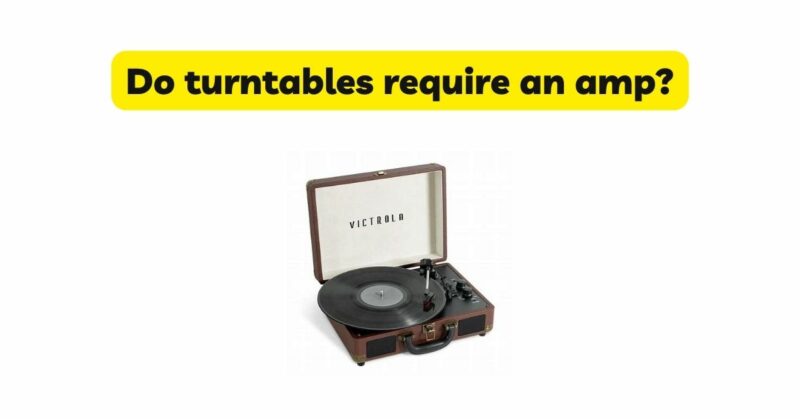Turntables have long been a symbol of high-fidelity audio and a cherished medium for music enthusiasts. However, there is often confusion surrounding the requirement of an amplifier when setting up a turntable. In this article, we will delve into the world of turntables and examine whether they necessitate the use of an amplifier. By understanding the components of a turntable system, considering different setup options, and exploring the role of amplifiers, we aim to shed light on the need for an amplifier in turntable setups.
The Components of a Turntable System: To understand the need for an amplifier, it is essential to familiarize ourselves with the components of a turntable system. A typical turntable system consists of the turntable itself, a phono cartridge, a phono preamplifier (phono stage), an amplifier, and speakers. Each component plays a specific role in the signal chain.
The Role of the Phono Preamp: One critical component in the turntable system is the phono preamp. The phono preamp is responsible for amplifying and equalizing the low-level signal produced by the turntable’s cartridge. Some turntables come with a built-in phono preamp, while others require an external phono preamp. The inclusion or absence of a built-in phono preamp determines the need for an external amplifier.
Integrated Amplifiers vs. Separate Components: When considering whether a turntable requires an amplifier, it is important to understand the distinction between integrated amplifiers and separate components. Integrated amplifiers combine a preamplifier (including a phono stage) and a power amplifier in a single unit. They are often found in all-in-one turntable systems or stereo receivers. Separate components, on the other hand, allow for customization by using separate phono preamps and power amplifiers.
Turntable Setup Options: The need for an amplifier in a turntable setup depends on various factors, including the presence of a built-in phono preamp and the desired audio configuration. Let’s explore a few common scenarios:
a. Turntable with a Built-in Phono Preamp: If your turntable has a built-in phono preamp, you can connect it directly to powered speakers or active monitors without the need for an external amplifier. In this case, the built-in phono preamp handles the amplification and equalization of the signal.
b. Turntable without a Built-in Phono Preamp: If your turntable does not have a built-in phono preamp, you will need an external phono preamp to amplify and equalize the signal before it can be connected to an amplifier or powered speakers. In this scenario, an amplifier becomes necessary.
c. Customized System with Separate Components: If you prefer a customized setup, you will require both a phono preamp to amplify the turntable signal and a power amplifier to drive the speakers. This configuration offers flexibility for choosing different components and potentially achieving higher audio fidelity.
Active vs. Passive Speakers: When discussing the need for an amplifier, it is important to mention the distinction between active and passive speakers. Active speakers have built-in amplifiers, allowing them to directly receive the signal from a turntable. In this case, an external amplifier is not required. On the other hand, passive speakers require an external amplifier to power them.
Considerations for Sound Quality: While the presence of an amplifier may not be mandatory in all turntable setups, it can significantly impact the sound quality. Dedicated amplifiers often offer higher power, improved signal processing, and better sound reproduction compared to built-in amplifiers found in some turntables or speakers. If achieving the best possible sound quality is a priority, investing in a separate amplifier may be beneficial.
Additional Benefits of an Amplifier: Apart from sound quality, an amplifier provides additional benefits. It serves as the control center for adjusting volume, tone, and balance. Amplifiers also offer connectivity options for other audio sources, such as CD players, streaming devices, or digital audio players, expanding the versatility of your audio system.
Personal Preferences and Future Expandability: The need for an amplifier ultimately depends on your personal preferences and future expandability plans. If you prioritize simplicity, convenience, and space-saving, a turntable setup with a built-in phono preamp and powered speakers may be sufficient. However, if you seek flexibility, customization options, and the potential for system upgrades, a separate amplifier becomes a valuable component in your setup.
Conclusion: While turntables themselves do not inherently require an amplifier, the necessity of an amplifier depends on the specific setup, the presence of a built-in phono preamp, and individual preferences. Integrated amplifiers or separate components can enhance the audio experience, offering greater control over sound quality and the ability to customize the system. Consider your turntable’s features, desired sound quality, and future expansion plans when determining whether an amplifier is necessary for your turntable setup.


